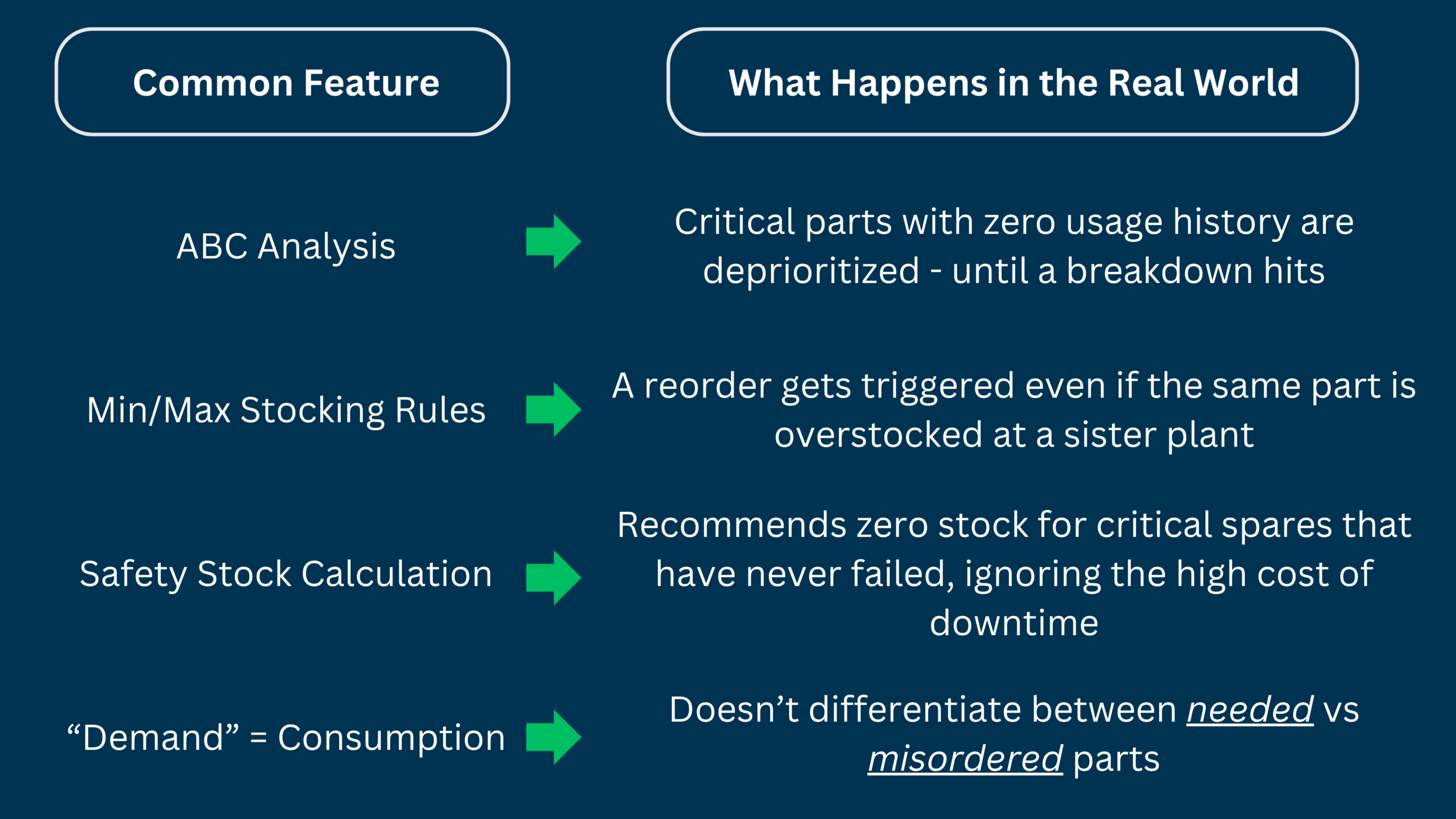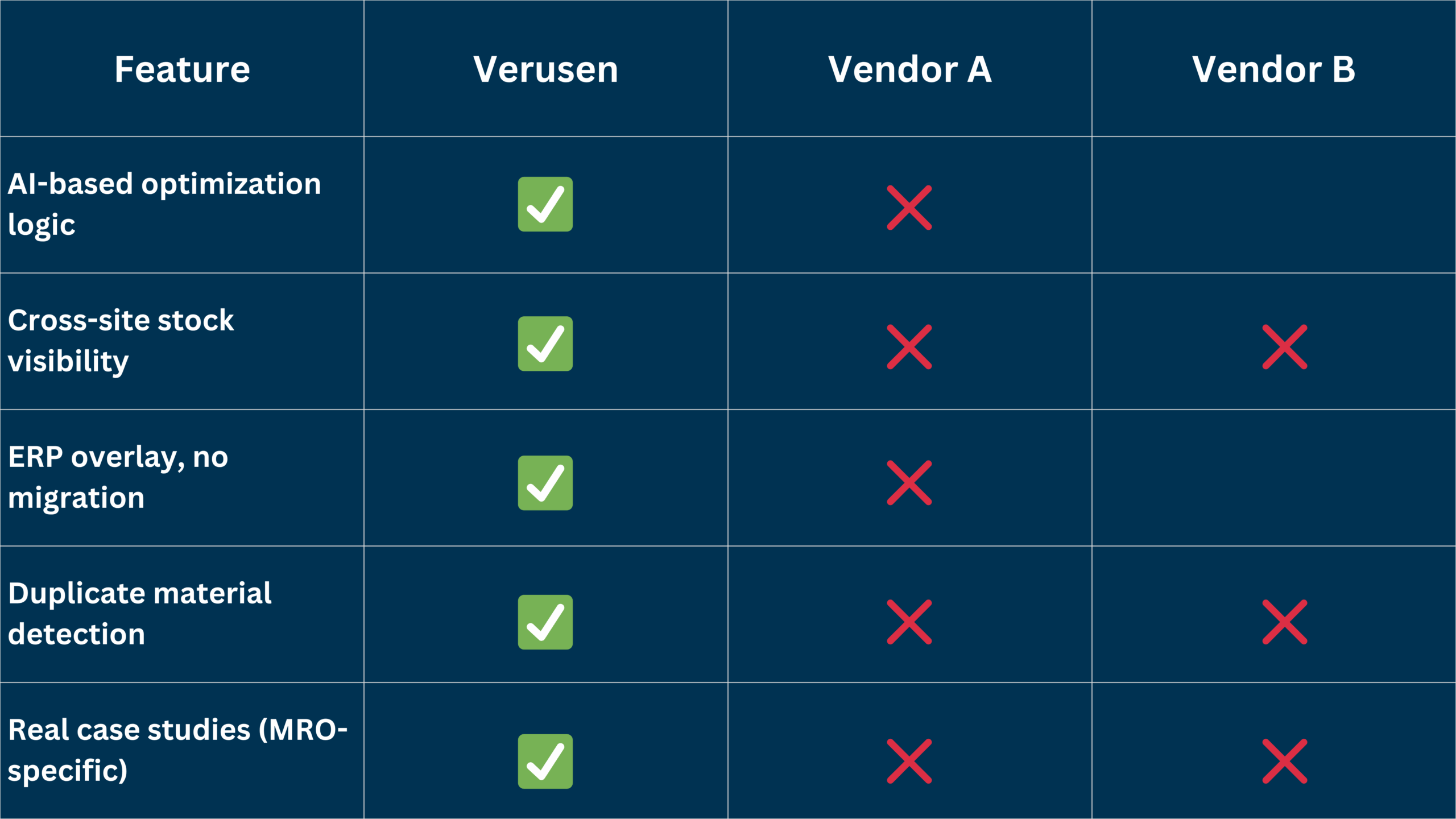Inventory Optimization Software: How to Evaluate Vendors (Without Getting Burned)
All Tools Promise Optimization. Only about 3 Deliver. Here’s How to Spot the Difference.

You’ve seen the claims:
“Reduce stockouts!”
“Automate planning!”
“Unlock working capital!”
Every inventory optimization software vendor says they’ll cut costs and improve performance – but when the dashboards go live… nothing changes.
Sound familiar?
Here’s the truth:
- Most inventory optimization tools were built for finished goods, not MRO.
- They optimize by SKU, not by reliability risk.
- They assume clean data. You don’t have that.
This guide will help you spot the difference before your team spends 6 figures on a system that doesn’t fix the problem.
In This Guide:
- The 5 capabilities you absolutely need (and why most vendors miss them)
- How to evaluate optimization logic – not just user interface
- Key questions to ask vendors to shows who’s real
- Why MRO requires a different playbook than production inventory
Most Optimization Software Isn’t Built for MRO
Most optimization software wasn’t designed for low-velocity, high-risk indirect materials. It was designed for finished goods – fast-moving SKUs with clean demand data.
But MRO isn’t that.
It’s fragmented, tribal, and often undocumented. Here’s what that mismatch creates:


Result?
A planner places a $22,000 rush order for a critical valve, unaware that the same part is in stock at a plant four hours away, mislabeled with a different SKU.
Multiply that by 1,000 SKUs across 15 sites, and you’re looking at millions in hidden waste.
This is why MRO inventory needs purpose-built optimization, not just borrowed tools from production supply chains.
What to Look for in MRO Optimization Software
1. Confidence-Based Optimization Logic
Great MRO optimization software doesn’t just flag reorders. It quantifies certainty and exposes why a part needs to be stocked, adjusted, or removed.
Verusen’s AI, for example, calculates a confidence score for every recommendation based on:
- Cleaned + unified part description data
- Supplier lead times and risk classification
- Inventory redundancy across plants
- Usage volatility (e.g., seasonality, one-off events)
- Maintenance criticality tier (is this part tied to uptime?)
This is not just a smarter reorder point.
It’s an actionable insight backed by probability and operational context.
2. Cross-Site Visibility & Virtual Consolidation
Can it show you what’s in stock across all plants, not just locally?
Look for: Multi-site dashboarding, virtual stock views, reorder optimization based on pooled availability
3. AI-Driven Duplicate Detection
If the tool assumes your data is clean, run.
If it fixes duplication without rewrites, you’re in the right place.
Look for: NLP-based part matching, similarity scoring, MRO-specific taxonomies
4. ERP Compatibility Without Migration
You should not need to rip out SAP, Oracle, or Maximo just to gain intelligence.
Look for: Non-invasive overlays, plug-in architecture, clean API exposure
5. Real Proof – Not Just a Demo
Ask for results, not roadmaps.
If they don’t have a customer who looks like you, be wary.
Look for:
- % inventory reduction
- Supplier consolidation metrics
- Time to value (measured in weeks, not quarters)
Vendor Scorecard Example Template

CASE SNAPSHOT: What Good Looks Like
Company: Fortune 500 Packaging Company
Before:
- Siloed data hindered MRO visibility.
- Critical part failures, 4-week downtime threat
- Misaligned teams caused excess inventory
After (with Verusen):
- Unified MRO data, full visibility achieved
- Global search located parts, saved >$1M
- $59M identified savings, reduced downtime risk
7 Questions to Ask Every Vendor
- How do you handle dirty or duplicate MRO data?
- What’s your confidence scoring method?
- Can I see inventory across sites in one view?
- What does your ERP integration look like?
- Do I need to change anything in our ERP?
- Who’s using this in manufacturing/MRO right now?
- What’s your fastest time to value?

FAQs
How fast can I see results?
Most customers see initial optimization insights in under 30 days.
Can we start with a pilot?
Yes. One plant, one product line, or one category. Your call.
Choose Software That Works With Your Chaos – Not Against It
You don’t need a prettier dashboard.
You need a smarter system – one that understands the complexity of MRO, adapts to your reality, and delivers results fast.
→ Book a Comparison Demo with Verusen vs [Your Current Stack]
